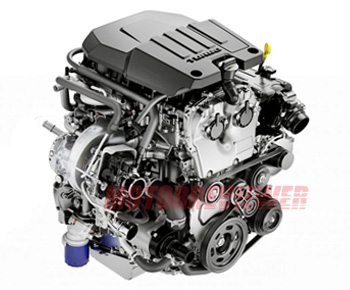GM 2.7L L3B Turbo Engine Specs, Problems, Reliability, Info

GM 2.7L L3B Overview
The GM L3B engine is the all-new 2.7-liter four-cylinder turbocharged gasoline engine that debuted in the 2019 Chevrolet Silverado 1500 and 2019 GMC Sierra 1500. This engine was designed specifically for use in full-size pickup trucks, and by the way, it is the first 4-cylinder ever used for GM's full-size pickups. The L3B engine is produced in the USA at Spring Hill Manufacturing, a General Motors factory in Spring Hill, Tennessee.
GM 2.7 Turbo L3B Engine Design
The 2.7 Turbo L3B has a deep-skirt, liberally ribbed die-cast aluminum (380 T5) cylinder block with iron liners. It features a long piston stroke of 4.01 inches (102 mm) that provides strong low-end torque, but on the other hand, this increases vibrations. To bring smoothness back, the engine block was equipped with a dual balance shaft mechanism. The engine block also has a forged steel crankshaft with hardened journals and tri-metal bearings. The crankshaft is offset from the cylinder bore centerline. The offset position reduces friction from piston side-loading. Pistons themselves are lightweight aluminum with fully machined crowns and cast iron ring carriers. Pistons are additionally cooled by oil spray squirters. The engine is equipped with a continuously variable-output oil pump. The oil pump, together with balance shafts, is supported by a bolt-on aluminum lower crankcase extension. The bottom side is sealed by a nylon-reinforced plastic oil pan.
On top of the engine block, there is an aluminum alloy (356 T5) 16-valve cylinder head with high-tumble combustion chambers and dual-overhead camshafts. The cylinder head uses copper-alloy exhaust valve guides for exhaust valves to improve heat transfer and valve cooling. The intake and exhaust camshafts are driven by an 8-mm roller timing chain. The 2.7L L3B valvetrain features GM's Sliding Cam Valve Lift System (SCS), which has three distinct operating modes: High Lift, Low Lift, and AFM (Active Fuel Management) mode. During High Lift mode, all cylinders are active, and all valves are open to their maximum lift. Low Lift Mode (3 mm less) reduces the duration of the intake valve opening to help save fuel under medium load conditions. In AFM mode, cylinders 2 and 3 are deactivated, reducing fuel consumption in light load conditions. Moreover, the intake and exhaust sides also come with continuously variable valve timing management.
The L3B engine features a high-pressure direct fuel injection system. The high-pressure fuel pump delivers up to 3000 psi (20 MPa) of fuel pressure for side-mounted direct injectors that are able to provide up to three injection events per combustion cycle. The direct injection works together with a high-energy coil-on-plug electronically controlled ignition system called Spark Ignited Direct Injection (SIDI). Like most modern turbocharged engines, the 2.7 L3B utilizes a cylinder head design with an integrated and water-cooled exhaust manifold to shorten the engine warm-up period (for passing emissions tests) and prolong the turbocharger life, keeping it "cool" during high loads. The engine uses the latest BorgWarner's single dual-volute turbocharger that delivers 22 psi (1.5 bar) of max boost. This turbocharger uses an electrically actuated wastegate. The pressurized air goes through an air-to-air intercooler that lowers its temperature by about 130 degrees F (74 C). One more unique feature of this new engine is GM's active thermal management cooling system. This system consists of an ECM-controlled electric water pump and a 3-way rotary valve. An electric water pump supplies coolant flow to heat the passenger compartment and cool the engine and transmission.
What's the End Result?
The new GM L3B 2.7L engine was designed with a target to replace the 4.3L V6 engine, and engineers coped with the task successfully. It produces 9% more horsepower and 14% more torque, weighs 80 lbs (36 kg) less, and consumes 13% less fuel with better emissions than its predecessor. But compared with a major competitor, Ford's V6 2.7-liter EcoBoost engine (325 hp and 400 pound-feet of torque), the GM 2.7-liter 4 banger loses the performance battle, producing 310 hp and only 348 pound-feet of torque.
Engine Specs
Oil recommendations and capacity may vary depending on the car model, year, and market. Please check the service manual specific to your vehicle!
2.7 L3B Turbo Engine Problems and Reliability
Is the GM 2.7 L3B a good and reliable engine? Well, it is very well-packed with all sorts of technology to boost fuel efficiency and performance. So many things may go wrong, but GM claimed the new engine successfully accumulated an equivalent of over one million miles of over-the-road durability validation testing. However, only real life and time will tell how reliable GM's new 2.7-liter turbo engine is.
Carbon Build-up Issue
But for now, be sure that the engine is more sensitive to the quality and condition of the engine oil, like all modern turbocharged and direct-injected engines are. A lack of maintenance will destroy this engine very quickly. The fuel delivery system has a controversial decision to use direct injection only, while almost all direct-injected-only engines from other manufacturers were revised and received combined direct and port injection. Combined fuel injection prolongs the life of the cylinder wall surface and prevents carbon buildup on intake valves and walls inside intake ports.
